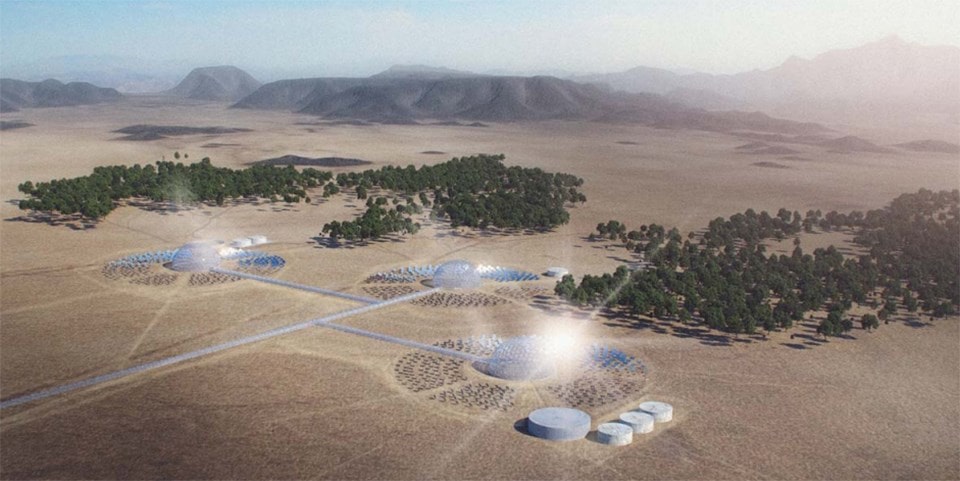An innovative company’s approach to desalination promises zero emissions while significantly reducing operating costs. Solar Water’s desalination domes, built from glass and stainless steel, convert saltwater for industrial or human use with minimal power input. The construction of two desalination domes is already underway in the Middle East, and company executives believe their technology can offer a viable solution to the planet’s water crisis.
^ Desalination Plant
Article by Daniel Sweet
___
Meet Mr. Reavley
David Reavley is a highly experienced executive who has held board positions in the UK and internationally in public companies within the telecoms and technology sectors. David is a specialist in developing and implementing sales/ marketing strategies and establishing global distribution networks. As CEO of a management consultancy, he designed and delivered staff development programmes internationally. David is a frequent speaker at conferences, a published author, and a visiting lecturer at University College London. David was led to join Solar Water not only because of its proven, award-winning solution but also because of its obvious global benefits.
According to the World Wildlife Foundation, some 1.1 billion people worldwide lack access to safe drinking water—a continuously increasing statistic due to climate change. Desalination technology has been touted as a potential solution to this crisis, but as David Reavley points out, harmful emissions associated with traditional desalination plants often undermine the intended benefits. As an alternative, Mr. Reavley’s company has developed a clean, emissions-free process for desalinating water that is already gaining traction in the Middle East. In a recent interview, Solar Water CEO David Reavley explained how the company’s desalination domes work, along with a short history of their development.
“A desalination dome uses concentrated solar power to boil seawater and convert it to steam, which then condensates and is recollected as clean water.”
“In practice,” Mr. Reavley continued, “a Solar Water installation comprises a dome structure (the upper dome) made of highly conductive steel struts and glass panels, built over a basin (the lower dome) into which seawater is pumped via glass enclosed aqueducts. These transparent aqueducts expose the seawater to the sun as it moves towards the dome, initiating a steady rise in temperature. Once the water reaches the interior of the dome, solar tracking mirrors (heliostats) positioned in a wide circle around the structure concentrate solar energy on the upper dome, converting the seawater into a mass of pressurized steam. This is discharged out into through-puts and condenses into fresh water for human consumption and industrial purposes. The brine gathers at the bottom of the cauldron, then is extracted and sold commercially as salt.”
Research and development
According to Mr. Reavley, the research and development behind the desalination dome went on for two and a half years, in association with Cranfield University in the UK, before commercialization. “After years of diligent research and experimentation, the Solar Water team decided there was sufficient academic science behind the idea, and in working with Cranfield University, a small model was created as a proof-of-concept.”
“Through several meetings, symposiums, trade fairs, and working closely with Department of International Trade (DIT), Solar Water has secured two contracts, and we have a pipeline going from Egypt to the Philippines, Thailand to South Africa, and India to Bangladesh. Construction on our first dome, in Neom, Saudi Arabia, is now scheduled to start at the beginning of June.”

The Neom dome
The Neom project in Saudi Arabia features a 20m desalination dome intended to support workers involved in a large-scale construction project. Neom itself is a planned smart-city in the northwestern region of the country and will include multiple towns, ports, enterprise zones, research centers, sports and entertainment venues, and tourist destinations.
“Conversely, the water that will be produced in Aqaba, Jordan will be used for an industrial process that will enable the Jordan Phosphate Mines company to expand their product line, ultimately improving the economy of the country. In this way, Solar Water’s desalination technology is adaptable to the situation at hand, improving water access and economies.”
Water output, rated for size
Keeping client need at the centre of decision-making, Solar Water adapts the design of their desalination domes on a case-by-case basis. With this in mind, various desalination dome sizes are available depending on the client’s requirements. Sizes range from 20m domes all the way to 80m, with varying levels of water output.
Operating costs
As well as being cheaper, quicker and easier to build than other desalination systems, the operating costs are greatly reduced for a number of reasons, not least because no fuel is consumed, and with no moving parts the maintenance costs are low, requiring few engineering staff. Furthermore, the by-product of this process is salt which has a commercial value which potentially covers the annual maintenance cost. Other systems produce brine which is pumped back into the sea, destroying marine life.
“Our solution will aid the reverse of climate change and enable communities to thrive whether there will be urban, industrial, agricultural or tourism base.”
Visit www.solarwaterplc.com to read more about Solar Water.

